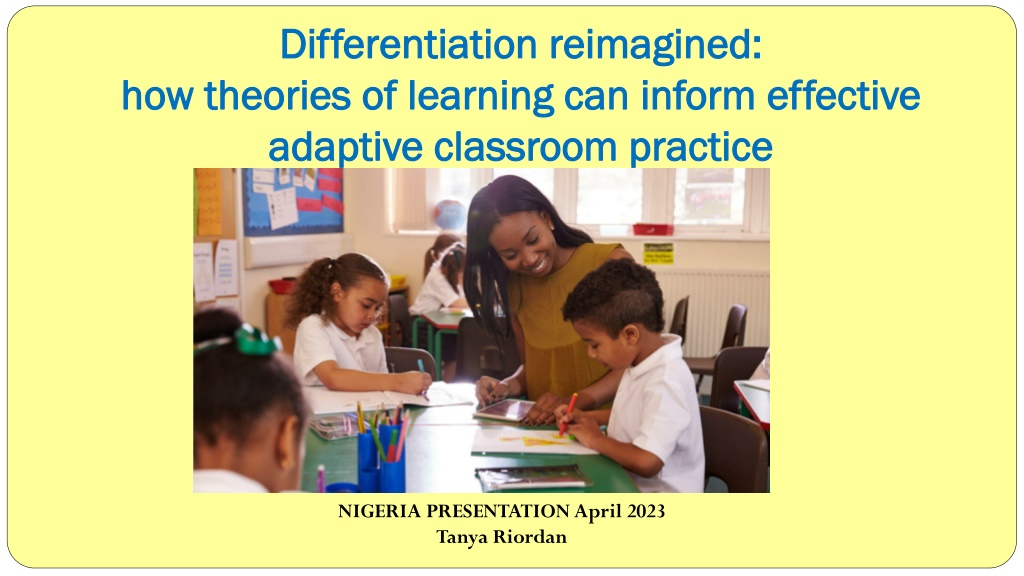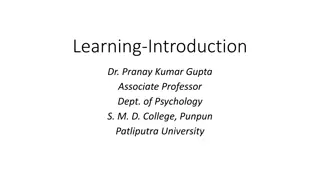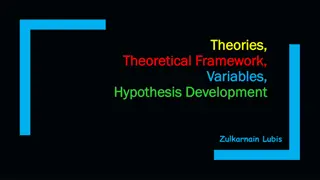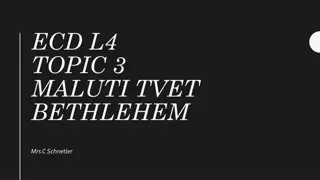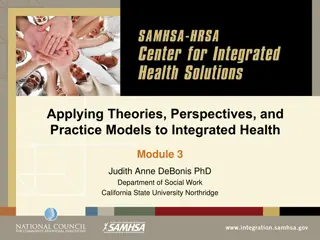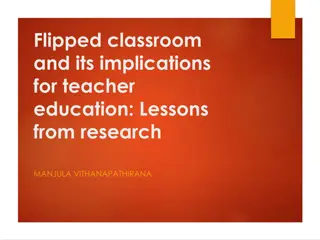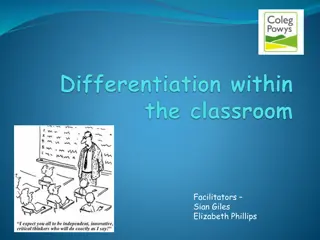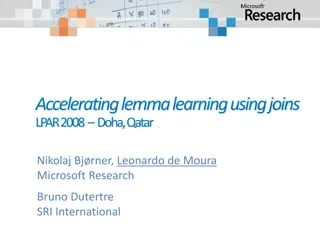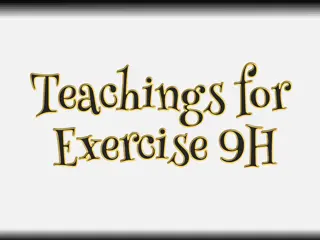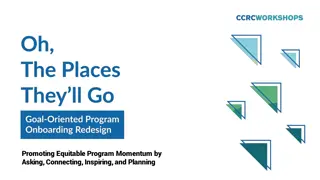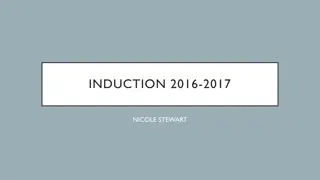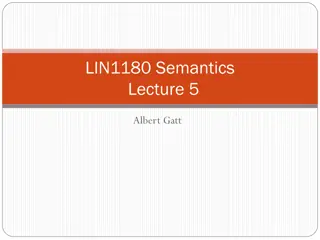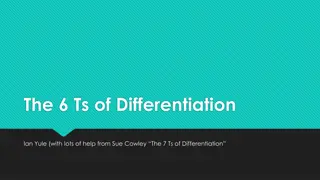Reimagining Differentiation: Enhancing Classroom Practice Through Learning Theories
Explore how theories of learning can inform effective adaptive classroom practice, focusing on the concept of differentiation. The presentation delves into reimagining differentiation, key theories supporting it, and practical strategies to support differentiation in language classrooms. The research aims to enhance understanding through literature review and practitioner-led inquiries, shedding light on the complex and contested nature of differentiation. A reimagined definition emphasizes valuing all learners and strategic planning to meet individual needs.
Download Presentation

Please find below an Image/Link to download the presentation.
The content on the website is provided AS IS for your information and personal use only. It may not be sold, licensed, or shared on other websites without obtaining consent from the author. Download presentation by click this link. If you encounter any issues during the download, it is possible that the publisher has removed the file from their server.
E N D
Presentation Transcript
Differentiation reimagined: Differentiation reimagined: how theories of learning can inform effective how theories of learning can inform effective adaptive classroom practice adaptive classroom practice NIGERIA PRESENTATION April 2023 Tanya Riordan
Session aims and outline: Briefly report our research with student teachers looking at links between learning theory, differentiation and classroom practice Present a reconceptualization of the notion of differentiation Revisit key theories which help underpin the concept of differentiation: the ZPD, scaffolding and contingency Explore generic ideas and tasks to support differentiation in language classrooms
Our research aimed to explore the concept of differentiation in relation to how it is currently practised in language classrooms, through: 1. An in-depth literature review including theories of learning 2. A small-scale practitioner-led inquiry with qualitative data collected from 3 sources: (i) Student Teachers on an initial teacher training course (reflections and teaching materials); (ii) Mentors (focus group discussions) (iii) Course Tutor (teaching materials to illustrate concept of differentiation and journal reflections)
Definitions of Differentiation Definitions of Differentiation A complex and contested concept A wide-ranging term, difficult to define, many interpretations, no common consensus Incorporates many elements of good teaching , for example: general and individualised feedback; formative assessment; collaborative learning; positive reinforcement; teacher questioning; peer tutoring; flexible grouping; active engagement; positive classroom environment Confucian philosophies of teaching and learning: Vary the way you teach according to the person you teach; teach in a way that best suits the ability of the learner; teach in a way that makes the best use of the circumstance/context/material available (Professor Li Wei, 2021, p.35)
A reimagined definition: Differentiation is an approach to learning and teaching where the needs of all learners are recognised, planned for, and valued. Teachers take time to get to know their learners through scrutiny of class data; through observation within and out of lessons; and through ongoing discussion with individuals. Differentiation is a mode of thinking which, once espoused, becomes embedded in a teacher s repertoire. Through strategic planning of lessons around core learning objectives and the design and adaptation of branching activities catering for individual differences and preferences, teachers can ensure that all students are working within the ZPD and challenged to go just beyond what they can already do unaided (Vygotsky, 1978). With the provision of positive, constructive feedback, all learners will then experience opportunities to make progress and achieve their full potential. In a differentiated classroom, learning can be adapted through individual student questioning, monitoring, support, and group work rather than by differentiating separate tasks into levels. Students are enabled to make choices about their own learning needs whilst being challenged to work at an appropriate pace. (Riordan and Convery, 2021, p.26)
Differentiation or Adaptive Teaching? (what s in a name?) Latest Government policy documents refer to adaptive teaching rather than differentiation Adaptive teaching is less likely to be valuable if it causes the teacher to artificially create distinct tasks for different groups of pupils or to set lower expectations for particular groups (ITT Core Content Framework, DfE, 2019, p.20) Adapting teaching in a responsive way, for example, by providing focused support to pupils who are not making progress, is likely to improve outcomes. However, this type of adaptive teaching should be clearly distinguished from forms of differentiation that cause teachers to artificially create distinct tasks for different groups of pupils (Ofsted Education Inspection Framework, 2019, p.17)
Differentiation or Adaptive Teaching? Many ideas outlined similar to those previously identified as differentiation e.g. students learn at different rates; they need different types of support; have different levels of prior attainment; can be flexibly grouped effectively Shift in focus to: 1. providing targeted support for learners who require it, enabling teachers to be more efficient in decision-making 2. spending more time interacting with learners 3. giving more wait time 4. making sure all students receive enough praise and encouragement
How useful are learning theories for enhancing differentiation? inform planning and teaching to construct the most effective learning opportunities for our students help explain how students gain knowledge and understanding guide our responses to individual learners assist in the diagnosis of in-class problems help us to understand and evaluate our practice support classroom observations of learning and teaching
Theories of Learning and Teaching which provide a framework for differentiation Vygotsky s socio-cultural theory of mind/social development theory, including the ZPD Bruner s theory of scaffolding Wood s theory of contingent teaching/tutoring
Vygotskys Zone of Proximal Development (ZPD) The ZPD refers to the gap that exists for an individual between what (s)he is able to do alone and what (s)he can achieve with help from someone more knowledgeable or skilled Atherton J S (2013) Learning and Teaching; Constructivism in learning [On-line: UK] retrieved 7 December 2021 from http://acbart.com/learningandteaching/LearningAndTeaching/www.learningandteaching.info/learning/constructivism.html
Implications for classroom differentiation: Co-operation and interaction lie at the basis of learning Support within the ZPD by a MKO (teacher, other adult or peer) can help children to learn Pitching work at a level accessible to all learners Some children are able to learn more in the ZPD than others
Bruner and scaffolding Q: What is scaffolding? A:A form of adult assistance that enables a child to solve a problem, carry out a task or achieve a goal which would be beyond the child s unassisted efforts Q: What form does scaffolding take? A: Many different forms, depending on the task, for example: a nod or smile of encouragement a verbal prompt a suggestion or hint modelling of an answer thinking aloud
Implications for classroom differentiation Anticipation, at the planning stage, of the difficulties learners may face and how to provide the appropriate support Will all students have equal access to the support? Focus on the processes of learning, not just the learning itself Create thinking skills and problem-solving approaches (metacognition) Provision of challenging and motivating learning opportunities
Woods theory of Contingent teaching/tutoring When a learner is struggling, the teacher steps in to help and get the student on track Once the student has started the task, the teacher gradually withdraws the support 5 levels of contingency (support): 1. General encouragement or verbal prompt 2. Specific verbal instruction 3. Assists in choice of material 4. Prepares material 5. Demonstration
Implications for classroom differentiation: Being responsive to individuals Creating opportunities for one-on-one interaction Finding the time to devote to each individual student on an equitable basis Being reactive to circumstances as they happen Listening to the responses of individual students and finding on the spot solutions Judging when to offer, and when to withdraw, support
Planning for Differentiation no more levels! Core and branching activities make these explicit on lesson plans Break down the learning into manageable chunks ALL students need to be challenged All students need reinforcement tasks at some time Take into account student diversity what background knowledge/interests/strengths do students bring to the lesson, and how can you build on these? Progression in learning (that +1 element, or ZPD) Formative assessment opportunities and constructive feedback
Types of Differentiation Text Task Outcome Support Resource Interest creativity, enjoyment, fun Choice NOT by attainment, 3 levels discouraged by Ofsted in the UK
Practical ideas leading to Differentiation (1) Teacher questioning question types: yes/no, closed, either/or, open, probing, follow-on Think/pair/share Wait time Judging how to pitch questions into each student s ZPD How to scaffold questions repeating/rephrasing/ simplifying/using body language/passing the question on Allowing students to pose their own questions: what questions do you want to ask me about this topic?
Practical ideas leading to Differentiation (2) Pair work: static pairs moving pairs interviews speed dating back-to-back conversations information gap role plays paired reading surveys
O_ h _ _ _ _ _ _ t _? J'_ _ _ _ _ _ _ P_ _ _ _ _ _ _ _ _ ? -----------------------
Parallel translation 1 ___ ___ gusta viajar en avi n porque _________ me hace vomitar y adem s es _________ ____________. 1 I don t _______ _________ ___ ______ _______ sometimes it makes me sick and what s more it s very uncomfortable. 2 _________ ___ ______ __________viajar en autocar, ____ _____ _______ e inc modo, as que _________ el tren. 2 Although it s cheaper ______ ____ _______, it is very boring _______ and uncomfortable, _____ I prefer the train. 3 Para m lo ______es el ________ porque es _____ r pido y es __________emocionante. 3 _____ _____ ____ best is the plane because it s very ______ and quite ____________.
Parallel translation 1 ___ ___ gusta viajar en avi n porque _________ me hace vomitar y adem s es _________ ____________. No me a veces muy inc modo 1 I don t _______ _________ ___ ______ _______ sometimes it makes me sick and what s more it s very uncomfortable. like to travel by plane because
Practical ideas leading to Differentiation (3) Group work: jigsaws (home and expert) snowballing carousel projects fishbowl - flipped learning
HELMUT: Dieter, was mchtest du? DIETER: Eine Tasse Kaffee, bitte HELMUT: Gut. Dreimal Kaffee bitte, Fr ulein MARIA: Nein, ein Glas Orangensaft f r mich, bitte HELMUT: Gut also, zweimal Kaffee und ein Glas Orangensaft FR ULEIN: Also, ein Glas Orangensaft und zweimal Kaffee, ich komme gleich.
Once memorised, choose from one of the tasks below 1. Change the items underlined 2. As above and then add something e.g. order a snack or ask where the toilets are 3. As 1 and 2 above but then create a problem: the coffee machine has broken or the toilets are closed 4. Record your final conversation
ShyM: la nouvelle princesse de la musique franaise Shy M est une chanteuse fran aise. Elle est souvent compar e Rihanna. Elle est maintenant une grande star sur internet, avec des millions de vues sur YouTube. En 2012 et 2013, elle a gagn le prix NRJ Music Awards de la meilleure artiste f minine. En r alit , Shy Ms appelle Tamara Marthe. Elle a 31 ans. Elle a pris le nom de Shy parce qu elle est timide. Puis, elle a choisi la lettre M pour Martinique, une le fran aise dans les Cara bes. Son p re y habitait avec ses grands-parents. Shy m est fan des Red Hot Chili Peppers et de Beyonc . Mais elle est aussi influenc e par le zouk , un style de musique martiniquaise moderne. En 2006, elle chante Femme de Couleur , en hommage la Martinique et ses racines culturelles. La chanson est tr s populaire. Au coll ge, Shy m voulait devenir danseuse. En 2011, elle participe la saison num ro deux de Danse avec les Stars . C est la version fran aise de Strictly Come Dancing . Elle gagne le grand prix ! Apr s, dans les saisons trois et quatre, elle prend place parmi les juges.
ShyM est une chanteuse franaise. Elle est souvent compare Rihanna. Elle est maintenant une grande star sur internet, avec des millions de vues sur YouTube. En r alit , Shy Ms appelle Tamara Marthe. Elle a 31 ans. Elle a pris le nom de Shy parce qu elle est timide. Puis, elle a choisi la letter M pour Martinique, une le fran aise dans les Cara bes. Son p re y habitait avec ses grandparents. En 2006, elle chante Femme de Couleur , en homage la Martinique et ses racines culturelles. La chanson est tr s populaire. En 2011, elle participe la saison num ro deux de Danse avec les Stars . C est la version fran aise de Strictly Come Dancing . Elle gagne le grand prix ! En 2012 et 2013, elle a gagn le prix NRJ Music Awards de la meilleure artiste f minine.
Son chat chante sa chanson Trois petites truites cuites Trois petites truites crues Un chasseur sachant chasser sait chasser sans son chien de chasse Mon p re est maire, mon fr re est masseur Cinq gros rats grillent dans la grosse graisse grasse
Key Points to Take Away Respond to the individual needs of your learners Provide challenge and reinforcement for ALL your students Think: core and branching activities Provide formative assessment opportunities and give constructive feedback Make time for subject pedagogy theory Have a shared and agreed definition of differentiation with your team Be creative
